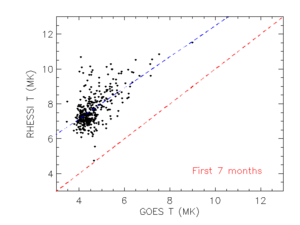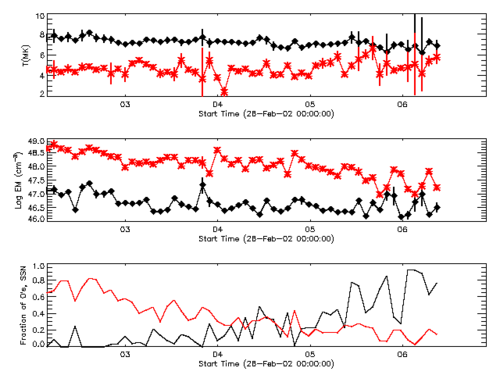High Temperatures in Active Regions
From RHESSI Wiki
Jmctiernan (Talk | contribs) |
Jmctiernan (Talk | contribs) |
||
| Line 58: | Line 58: | ||
What happened is that as the solar cycle moved along, the Xrays seen by GOES decreased to the point where the T measurements are being affected by background. Or at least this is what we expect; we don't have the same easy method for background subtraction for GOES here that we have for RHESSI. This erodes confidence in the GOES measurements -- below an EM of 3x10<math>^{48}</math> cm<math>^{-3}</math>, GOES T is often higher than RHESSI T, and the results are suspect. (This is C level in the GOES long wavelength channel -- which is typically only seen when the Sun is at its most active.) | What happened is that as the solar cycle moved along, the Xrays seen by GOES decreased to the point where the T measurements are being affected by background. Or at least this is what we expect; we don't have the same easy method for background subtraction for GOES here that we have for RHESSI. This erodes confidence in the GOES measurements -- below an EM of 3x10<math>^{48}</math> cm<math>^{-3}</math>, GOES T is often higher than RHESSI T, and the results are suspect. (This is C level in the GOES long wavelength channel -- which is typically only seen when the Sun is at its most active.) | ||
| - | Here in Figure | + | Here in Figure 5 is summarized the overall time variation of the RHESSI and GOES T and EM. The average RHESSI temperature is relatively constant for the mission, with a very slight drop from the 7 to 8 MK range to the 6.5 to 7.5 MK range. The RHESSI EM bounces up and down, but the bounces are superposed on a steady decrease of about one order of magnitude. Some of the bounces are pretty well correlated with the monthly sunspot number, particularly in 2002; the correlation coefficient between RHESSI EM and sunspot number is 0.61. The GOES values start |
relatively constant, and then become erratic at the start of 2003. (The average GOES T does remain lower than the average RHESSI T, even though the presence of GOES T higher than RHESSI T for individual intervals makes us distrust the GOES T.) The GOES EM decreases steadily by about 2 orders of magnitude. | relatively constant, and then become erratic at the start of 2003. (The average GOES T does remain lower than the average RHESSI T, even though the presence of GOES T higher than RHESSI T for individual intervals makes us distrust the GOES T.) The GOES EM decreases steadily by about 2 orders of magnitude. | ||
Revision as of 00:25, 14 March 2009
| Nugget | |
|---|---|
| Number: | 97 |
| 1st Author: | Jim McTiernan |
| 2nd Author: | |
| Published: | 16 March 2009 |
| Next Nugget: | TBD |
| Previous Nugget: | The Jakimiec Track |
| List all | |
Introduction
Since RHESSI was launched in February 2002, it has observed thousands of solar flares (more than 46,000 in the latest reprocessing of the RHESSI flare list). It was noticed in 2002 that RHESSI was observing solar emission even when there are no flares present (Ref. 1). The temperature required for this high energy emission is greater than 5 MK, a temperature range that is not often considered for solar active regions, mostly because the instruments used for T measurement of active regions, such as Yohkoh SXT, SOHO EIT or CDS, or didn't have much response to high T. Here we have measured the T for approximately 7000 time intervals from Feb 2002 through August 2006.
Background Subtraction and Interval Selection
Figure 1 shows the RHESSI count rate for a typical orbit for 8 April 2006. (Nothing special about April 2006, it was just a convenient option when the original SPD poster with this calculation was created.) The plot clearly shows a jump at the day-night transitions. That is solar emission. Two things need to be accomplished before we can get a T measurement of the steady-state component that would be related to active regions:
1) Avoid microflares, SAA's, particle events, etc: So for each orbit, an interval of between 1 and 5 minutes was chosen based on the following criteria: No flares or particle events, no attenuators, no data gaps, and at least 5 minutes from the SAA. The intervals chosen have the minimum (daylight) count rate for the orbit, subject to a flatness test that insures that there are no microflares in the intervals, there is one right after, though.
2) Find the background level: You cannot just assume that the background level can be given by the nighttime values before and after spacecraft day. The background level depends on the cosmic ray flux and local particle flux, and it varies with the position of the spacecraft. Figure 2 shows background data.

Here is how we calculate the background level: The count rate has been accumulated during the 5 minute periods before and after daylight for each orbit in the mission. Each spectrum has an energy range from 3 to 300 keV, which is split into 492 energy bands (1/3 keV resolution from 3 to 100 keV and 1 keV resolution from 100 to 300 keV).
The spectra are then averaged over time, longitude of the ascending node, and orbital phase. The angular ranges are split into 10 degree bins. A 56 day time interval is sufficient to ensure that there are measurements in each angular bin. For each 56-day time intervals, the spectra in each angular bin are averaged, resulting in a 36x36 array, for each of the 492 energy bands. We end up with an array of 492x18x36x36 for each 56-day interval; 492 energy bands, 18 detector segments, 36 bins of ascending node longitude, and 36 bins of orbital phase. Each of these arrays is stored in an IDL save file.
For a background spectrum for a given time from this database, restore the files accumulated for times that bracket the given time, and interpolate the spectrum over time and position. This can be done for any time or energy band for the whole RHESSI mission, and it is used for the RHESSI quicklook spectra.
The uncertainty in the background is the dispersion obtained in each of the angular bins during the averaging process. For the low-latitude regions where most of the temperature measurements were taken, the uncertainty in the background is approximately 1/2 the background rate. For the 3 to 6 keV energy band shown in Figures 1 and 2, this is approximately 1 count per second per detector. The uncertainty is higher for higher latitude regions; e.g., regions which are very dark in Figure 2.
Measurements
Now that we have a way to choose time intervals and calculate background, we can calculate the temperature and emission measure. A total of 8747 time intervals were analyzed, from 14 February 2002 to 2 August 2006. Of these intervals, 6961 had enough counts above the background level for a spectrum to be fitted. (The spectra for the fits were accumulated in 1/3 keV energy channels in the energy range from 3 to 30 keV. To be included in the fit, the background-subtracted count rate for a channel was required to be greater than 3 times its uncertainty. Detectors 1,3,4,6,9 were used.)
We also obtained T and EM from GOES data for each of the intervals, for comparisons. GOES 10 data were used prior to 16 March 2003, and GOES 12 data were used after.
The RHESSI temperature is between 6 and 11 MK, and the GOES temperature is usually between 3 and 6 MK. The GOES $EM$ is typically a factor of 50 to 100 times the RHESSI $EM$. This is consistent with a differential emission measure that decreases with increasing temperature.
There is a small problem, though. From Figure 3, it looks as if the two measurements have some correlation. This is not wildly unexpected, GOES should always measure a T lower than RHESSI, since it observes lower energy photons, so there should be some correlation due to that. We don't expect the correlation to be perfect; this would require the slope of the DEM to be a constant for all intervals.
In Figure 4, which shows all of the measurements, the rough correlation is gone, and often the GOES T is higher than the RHESSI T. This is not good, and it leaves us wondering: "Dude,what happened to GOES after 2002. The answer is "Dude, nothing happened to GOES. It's the Sun".
What happened is that as the solar cycle moved along, the Xrays seen by GOES decreased to the point where the T measurements are being affected by background. Or at least this is what we expect; we don't have the same easy method for background subtraction for GOES here that we have for RHESSI. This erodes confidence in the GOES measurements -- below an EM of 3x1048 cm − 3, GOES T is often higher than RHESSI T, and the results are suspect. (This is C level in the GOES long wavelength channel -- which is typically only seen when the Sun is at its most active.)
Here in Figure 5 is summarized the overall time variation of the RHESSI and GOES T and EM. The average RHESSI temperature is relatively constant for the mission, with a very slight drop from the 7 to 8 MK range to the 6.5 to 7.5 MK range. The RHESSI EM bounces up and down, but the bounces are superposed on a steady decrease of about one order of magnitude. Some of the bounces are pretty well correlated with the monthly sunspot number, particularly in 2002; the correlation coefficient between RHESSI EM and sunspot number is 0.61. The GOES values start relatively constant, and then become erratic at the start of 2003. (The average GOES T does remain lower than the average RHESSI T, even though the presence of GOES T higher than RHESSI T for individual intervals makes us distrust the GOES T.) The GOES EM decreases steadily by about 2 orders of magnitude.
| RHESSI Nugget Date | 16 March 2009 + |
| RHESSI Nugget First Author | Jim McTiernan + |
| RHESSI Nugget Index | 97 + |



